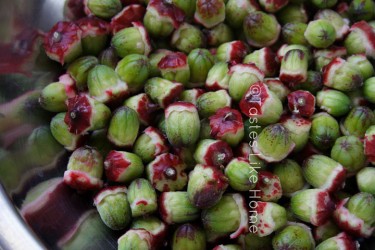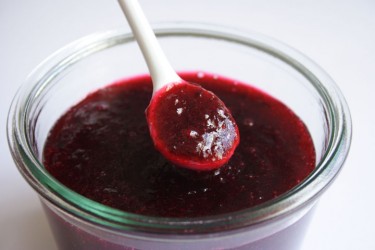Hi Everyone, with the end of the Sorrel season quickly closing in, I wanted to share with you a way in which you can still enjoy the flavour of sorrel beyond the season. No matter how much we love something there is only so much of it we can have at any time. So if you’ve had your fill of Sorrel drink but still can’t resist buying sorrel, bring it home and make some jam.
Sweet, tart and spiced, this jam has all the flavours of a tall, ice-cold glass of drink made from the same fruit. By the way, did you know that the leaves of the sorrel plant are edible, particularly the young leaves? They can be added to salads, and in the cuisine of the South Indian state of Andhra the leaves are tossed into dhals or sometimes mixed with spinach and cooked just as we would fry callaloo! Yup! I learnt this from one of my farmer friends at the market here in Barbados. And it doesn’t stop there; apparently, it is a widely used vegetable in Burma and is often cooked with shrimp or fish. Isn’t that something? Next season I want to get some of the leaves to cook.
it is a widely used vegetable in Burma and is often cooked with shrimp or fish. Isn’t that something? Next season I want to get some of the leaves to cook.
Sorrel is also like this super-fruit. It is documented as having one of the highest levels of antioxidants of any widely available food! It is also reported to have antihypertensive properties. In other words, it can help lower blood pressure. As you’re probably aware, the sorrel is used to make tea, flavoured water, and pro-health drinks due to the high levels of vitamin C found in the fruit. Gives you a whole new way to look at Sorrel doesn’t it?
Anyway, getting back to the jam. And again, I have to express how awesome Sorrel is. While you will need to have pectin from some other source – artificial or natural – when making jam with many fruits, you don’t need to look for the pectin elsewhere when making Sorrel jam. The pectin comes from the seeds of the Sorrel fruit! Boo-yah! So, essentially, you can make the jam with just the Sorrel and sugar.
You don’t want to read anymore right? You just want to go and make the jam? And depending on when you read this column, you will be vexed with yourself that you didn’t pick up the Sorrel at the market earlier in the day or even yesterday? Sorry.
All right, let’s get to down to making the jam.

You’ll need, Sorrel (of course), sugar, cinnamon sticks, whole cloves and water. Now you can use brown sugar or white sugar. The only reason I used white sugar for this jam was because I wanted to maintain the integrity of the ruby-rich colour of the Sorrel. Oh, you’ll need a blender, food processor or a potato masher, heck even a dhal-gutney would do.
Here’s what to do.
Remove the flowers (aka calyxes) from the seeds. Rinse the flowers and leave them to drain well in a colander. Meanwhile, add all the seeds to a pot, cover the seeds with water and place the pot on medium high heat. Drop in a cinnamon stick if you like to flavour the pectin. Cover and bring to a boil and cook for 15 minutes or until the seeds become translucent. In other words, you will be able to see through the outer membrane to the inside. The 15 minutes starts from the time the pot comes to a boil.
You want that liquid that the seeds were cooked in, that is where the pectin is; therefore, you have to strain off the seeds using a large sieve over a bowl to catch the liquid. Do it in batches if you don’t have a large sieve. Discard the seeds and spice if you used any.
Wipe the pot clean – the same one in which you boiled the seeds, or rinse it out if you like. Add back the drained liquid along with the flowers. Put in the cinnamon sticks and cloves, use whatever amount you would generally use when making drink. Cover the pot and place it on medium high heat and let it come to a boil. As soon as the pot comes to a boil, reduce the heat and let it simmer for 12 minutes. Shut off the heat and remove the pot from the stove.
In this next step, what has to be done is that you have to measure how much pulp you have as that will determine how much sugar you need to put in the jam. It is a 1 to 1 ratio. In other words, if you have 3 cups of pulp then you need 3 cups of sugar (measure by volume not weight). Don’t worry, it may seem like a lot of sugar but it isn’t. Remember that the Sorrel is highly acidic and also, the sugar works as a preservative. Of course you can choose to add less sugar if you so desire.

Now get yourself a measuring cup or a small bowl or a teacup. You will need to get a medium-sized bowl as well. Remove the cinnamon sticks and if you can find them easily, remove the cloves too, don’t worry if you miss a few. Using a slotted spoon, and shaking it to drain the excess liquid, measure off the pulp by filling the measuring cup, small bowl, tea cup or whatever you are using. Make a note of how many cups or bowls of pulp you have because you will need the same amount of sugar.
Set aside the pot with the liquid, you are not done with that. If you are using a blender or a food processor, add the pulp and puree it. You can make it as smooth or pulpy as you like. On the other hand, if you are using an immersion blender, a potato masher or your trusted dhal gutney, add the pulp back into the pot with the liquid and puree, mash or swizzle to your desired consistency.
If you used a blender or food processor, pour the mixture back into the pot with the liquid along with the sugar you have measured out. If you pureed the pulp right in the pot, then simply add the sugar. Put that pot back on to medium high heat and bring to a boil. Watch out! When the jam comes to a boil, it froths and rises high in the pot so ensure that your pot is no more than half full with the jam. Reduce the heat to low and simmer, giving it a proper stir every now and then. Let it cook until the jam sets.
The jam should stop frothing as it gets close to its setting point so that is a clue to watch for. To test if the jam is set, put a saucer in the freezer for about 10 minutes and then put a little of the jam on to it. Wait for it to cool and then push the top with your finger or a spoon, if it wrinkles, it’s done. Remove the jam and ladle it into sterilized jars, leave to cool completely and then close with an airtight lid. Or ladle the jam into hot sterilized bottles and seal immediately.
Eating the Jam
Use the jam just as you would any jam – on bread, biscuits, scones etc.
Serve it with any salty cheese or mild cheese.
Mix it with a little hot water to make a glaze for meats or any type of honey barbecue-like dressing. Use a little if making your own salad dressing too.
Gently heat the jam and stir in a good dollop of achar to make a spicy dip.
Make a dessert like jam tarts
If you think of other ways to use the jam, be sure to drop me a line.
Enjoy!
Cynthia





